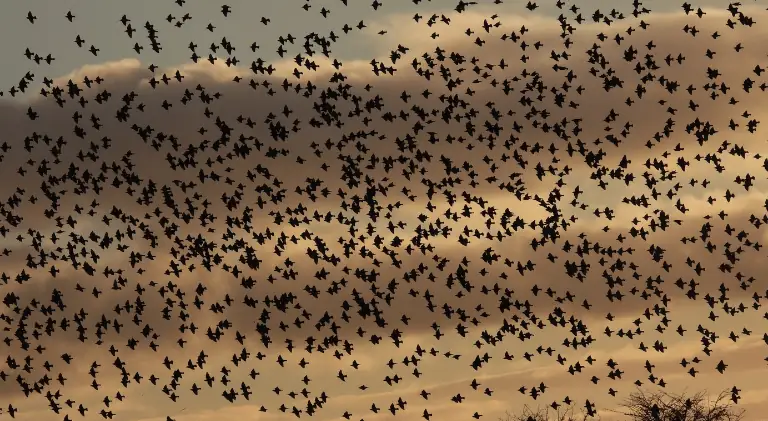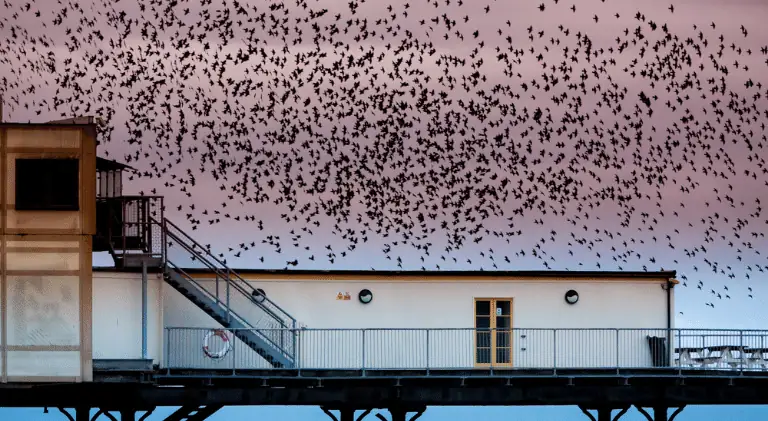Where to See Starling Murmuration in The USA
If you want to know where to see starling murmuration in the USA you are at the right place.
Starlings overwinter in huge flocks before migrating back to Northern Europe for the breeding season in Spring/Summer. These mega flocks form the amazing starling murmurations only visible from the air, which is why it’s so hard to find them.
If you want to see starling murmuration, you should head to the States in Fall (Sept/Oct). Starling murmurations are one of the most amazing natural phenomena, which shouldn’t be missed by any traveler.
When are they visible?
Around November-December. The best time to see them is around mid-November. They usually start leaving Europe for South America by mid-November and thus you can spot them in the States.
Where to see starling murmuration in the USA?

So, where to see starling murmuration in The USA? There are a couple of places that offer great chances to spot this amazing natural show:
- Central Park, New York City: This is the most common place for watching starling murmurations. The best time to watch them is at sunset right before they go to sleep (8:30 pm).
- Sunset Lake, New York City: Here you can see the starlings doing their evening dance and chirping as if playing some kind of a symphony. Around 40-50 thousand starlings gather here to roost.
- Lake Quinsigamond, Worcester: The best time here is sunrise (5 am). Don’t miss the amazing view of the murmuration from a boat – you can rent one in case it’s not your own.
- Los Angeles: This place offers great chances to see starling murmurations due to its numerous ponds and reservoirs with a dense population of starlings.
- Florida: One of the best places to see them is the Indian River Lagoon, Vero Beach (Florida). They form large flocks here.
- Astoria Park, New York City: The park is located at the border between Queens and Manhattan – around 3,000 starlings gather here every day.
- Lake Calhoun, Minneapolis: The lake is known for bird viewing especially in autumn when thousands of migrating waterbirds assemble here including geese, ducks, and waders. Starlings are also very abundant here so don’t miss your chance to see them!
- Archbald Pothole Region, Pennsylvania: Starlings love this region because of its wetland habitats and abundance of prey (insects, aquatic invertebrates, and frogs).
- Hennepin Canal Parkway State Park: Another great place to see them is the Hennepin Canal Parkway State Park (Illinois), where they roost in large numbers on trees.
Some Other Interesting Facts Related to Starling Murmuration
If you want to know more interesting facts about starling murmuration you should read the following lines!
Starlings are very social and group-living birds. In fact, they prefer living in groups rather than as singles or pairs.
They don’t migrate as a whole flock but instead do it in several smaller groups. This way is much safer and more efficient.
They usually fly at a safe height of 150-300 feet (45-90 meters). However, it’s not uncommon to see them flying as low as 30 feet above the ground. They do that, especially when going to roost.
Sometimes they even choose to sleep on a power line or a radio antenna!
They are also known for their amazing ability to change direction in no time, which is possible due to the fact that there’s a fluid dynamics phenomenon called the “Coanda effect” at work. It pushes them in one direction but then they turn and it pushes them again, repeatedly!
Moreover, there’s a scientific observation that starling murmuration changes shape according to the flock density and this is potentially useful for optimizing navigation.
in addition, It has been found that they sometimes merge into a shape of a letter “V” better to camouflage while protecting their backs from potential predators, such as hawks or falcons.
Starlings produce amazing sounds known as “chirping”. It’s not actually chirping but a mechanism that is similar to the “sonar” used by bats.
The Fascinating Science Behind Starling Murmurations
I find it pretty amazing that such a tiny bird like the European Starling (Sturnus vulgaris) can create such an amazing and mesmerizing sight. But, no need to be amazed for this is actually not magic but rather science!
European starlings do so due to two reasons: protection and food. Starlings don’t migrate as flocks but in smaller groups consisting of around 50-100 individuals. So, when you see such a flock it doesn’t mean that these are all the starlings flying around.
The thing is that this behavior evolved for protection against predators because there’s safety in numbers and staying close to your group mates means better chances of survival.
However, this behavior is not only present during the migration periods but also in winter so it’s definitely not all about “surviving”.
Starlings are social animals and they tend to live in groups. These flocks consist of both males and females, where the dominant individuals are usually males. They have dominant hierarchies just like other animal species!
Food is Another Reason for Starling Murmuration
Another reason why they gather in such flocks is for feeding. Starlings are omnivores, meaning that they eat both plants and animals, and their diet mainly consists of insects, fruit, seed, and nectar.
Thus, when you see such a flock it likely means that there’s an abundance of food nearby. They gather to feed on insects but also to defend their feeding territory against other starlings.
They do all this by chasing away members of their own flock! Thus, the smaller groups go after the larger flocks until they are broken up into smaller sub-flocks that can then feed without any conflicts.
Starlings Are Aggressive Birds!
Starlings are also known for being very aggressive birds. If you’ve ever tried to keep them away from your garden or balcony without success then this is because they are extremely stubborn and persistent when it comes to finding food!
So, when one of these starling groups sees a potential food source it marks the area with their feces and other secretions and they tend to return to this same spot as long as the food remains.
This behavior is known as “anting” and it involves covering themselves with their own feces! It probably serves as some sort of a territorial marker, since starlings are pretty territorial animals.
Starlings Aren’t Protected by Federal and State Laws

Wait, what? Starlings aren’t protected by any federal or state laws in the U.S.? Yes, I guess you heard me right…
You see, European starlings were brought to the U.S. in 1890s and they are quite popular for being good “pests” that control insects and aerate soils while eating waste and garbage.
However, they aren’t just “pests”, they also damage fruit trees and spread diseases! They are very active carriers of trypanosomiasis, which is a disease that affects humans and livestock.
As such, this means that killing starlings isn’t against the law but they can only be killed in self-defense.
So, you can’t really go out and hunt them for fun but if they are trying to get at your crops or threaten your life then it’s totally fine! And I guess doing so with a slingshot is pretty much self-defense! 😉
You probably have noticed that starlings are not protected by federal laws even though they are protected by state laws in most U.S. states
Well, the reason for that is that starlings are not native to North America and were introduced here quite recently, thus their protections depend on federal, not state, laws.
Starlings Eat Almost Anything!
Another interesting fact about them is that starlings tend to eat almost anything including seeds, fruits, snails, insects, earthworms, spiders, small rodents and even other birds!
They really love fruit especially if it’s rotting. They also feed on waste food at dumpsters and garbage cans. And another weird thing is that they sometimes feed on other starling carcasses!
According to some scientists, this is done to obtain minerals like calcium and phosphorus. They also feed on bat guano and feces of various animals such as horses and cows.
How Do Starlings Prevent Accidental Collision?
This is one of the most interesting questions! Starlings look like they are all over the place but it’s actually not so.
The truth is that they stick to two constraints: flock cohesion and obstacle avoidance. This means that they stay close to each other while trying to avoid obstacles, such as trees or buildings.
Their amazing ability to change direction is also a result of this behavior. In other words, their “fluid dynamics” phenomenon called the “Coanda effect” creates a pushing force that directs them in one direction but then they turn and it pushes them again, repeatedly!
However, what’s important to point out here is how they manage to avoid each other. They actually do so by recognizing the shape of another starling and “mirroring” it! The flock shifts so that all the stars change direction at the same time.
How Are Starlings Able to Chase Away Other Flocks?

Starlings don’t get along with many other bird species, including pigeons and certain types of sparrows. Thus, starlings will chase other birds and if they see a larger flock of the same species, odds are that it consists of members from smaller flocks and thus easier to drive away!
However, it’s not so much about fighting as chasing. Starlings like to harass their opponents either by pecking or sometimes even hitting them with their wings. The goal is to chase them away rather than actually hurting them!
By doing so, starlings are able to protect the area where they are feeding in order to avoid competition for food with other species.
The interesting thing about this is that only the most dominant individuals put their all into chasing others. Other members of the flock just join in for a short amount of time and then continue to feed.
However, their chasing activities can sometimes lead to fights with other species that are equal in size. In these cases being larger helps!
Starlings have a fighting style called “mobbing” where they attack the opponent by pecking them all at once rather than just one on one.
This is how they protect their feeding territory and this is why we often see them in large flocks. It’s much easier to chase away other species this way!
How Much Time Do Starlings Spend Outside Their Flock?
Starlings often stay outside of the larger flock, either because they want to be alone or because it’s not safe to be part of the flock.
This is especially true during nesting season when parents take turns hunting for food while the others stays at the nest with their offspring. During this time starlings are quite vulnerable to attacks by other birds or even cats!
However, they still travel in flocks due to lower chances of being attacked. Thus, when starlings leave their nests they are most vulnerable to attacks by predators.
So why do they travel in flocks if it’s dangerous? There are many possible answers to this question but the most likely is that not doing so would make them more vulnerable. Predators often attack lone birds!
Thus, starlings feel safer in flocks than outside of them, which is why they do so even during nesting season.
How Do They Group Together?
To understand this you need to know that starlings are actually very interesting birds! On one hand, they prefer to be alone and on the other, they can’t stay away from others for too long.
This is how they form groups consisting of between two and several dozen individuals (although they can often be found in flocks as large as 100).
Starlings are very social birds that like to be around others of their kind. This behavior is known as “flocking”. Their attraction to others is so strong that sometimes starlings will even sit on top of each other to fit into a group!
Starlings are often found in flocks but their interactions with others are never actually friendly! They only interact with each other to form groups or when they chase away intruders.
How Do They Recognize Each Other?
Much like humans, starlings recognize each other through certain body characteristics and features. Thus, they are able to identify members of their flock even after periods as long as several months.
However, like with humans, this isn’t enough for them to recognize individuals.
The only way for starlings to really know each other is by getting to know the bird’s voice and what it looks like!
By learning these things they can easily identify and tell apart each member of their flock.
How Do Starlings Communicate with Each Other?
Starlings vocalize when they feel threatened, in pain or when they interact with others. This communication is done through sounds so their way of communication is called “vocalization”.
This also means that they are able to communicate different ideas, feelings, and emotions through sounds. One sound is used to express anger, another to express excitement, and so on.
What Can We Learn From Starlings?

As with many animals, starlings may seem like they are very different from humans but in fact, their behavior can tell us a lot about ourselves! If you watch them you will notice that even though they are very social birds, they prefer being alone.
This is actually something that many humans can relate to! They feel lonely but enjoy being around others just as much.
This is the main reason why starlings mix so well with humans! Starlings eat almost anything and because of this, most people consider them as pests.
This may be bad for the local farmer who is trying to protect his crops but it’s very good for those people who feed wild birds!
Starlings are also naturally inquisitive and they interact very well with humans. This makes them perfect as pets and even as companions because if you keep a starling you will notice that it likes to stay by your side.
Starlings are very social birds that like to be with others of their kind, but they also like humans and often treat them as part of their flock!
They may sometimes act up and get on your nerves but in general, starlings make great pets. Their inquisitive behavior makes them easy to train and overall, they behave nicely around humans.
Are Starlings the Only Birds That Do Murmurations?
Yes, starlings are the only birds that perform murmurations. However, there are other animals that also do this! Some examples of these animals include insects, fish, and bats.
Murmurations are just another form of flocking that usually occurs within the same species.
Last Minute Thoughts
I hope you’ve enjoyed reading this article and found what you were looking for. As for a quick reminder on where to see starling murmuration in the USA, here are a few locations.
You can see starling murmuration in the following places in the USA:
- Central Park, New York City
- Sunset Lake, New York City
- Lake Quinsigamond, Worcester
- Los Angeles
- Florida
- Astoria Park, New York City
- Lake Calhoun, Minneapolis
- Archbald Pothole Region, Pennsylvania
- Hennepin Canal Parkway State Park
If you’ve enjoyed reading this article, please share it with your friends and family. Also, make sure to check out my other articles on birds and bird watching.






